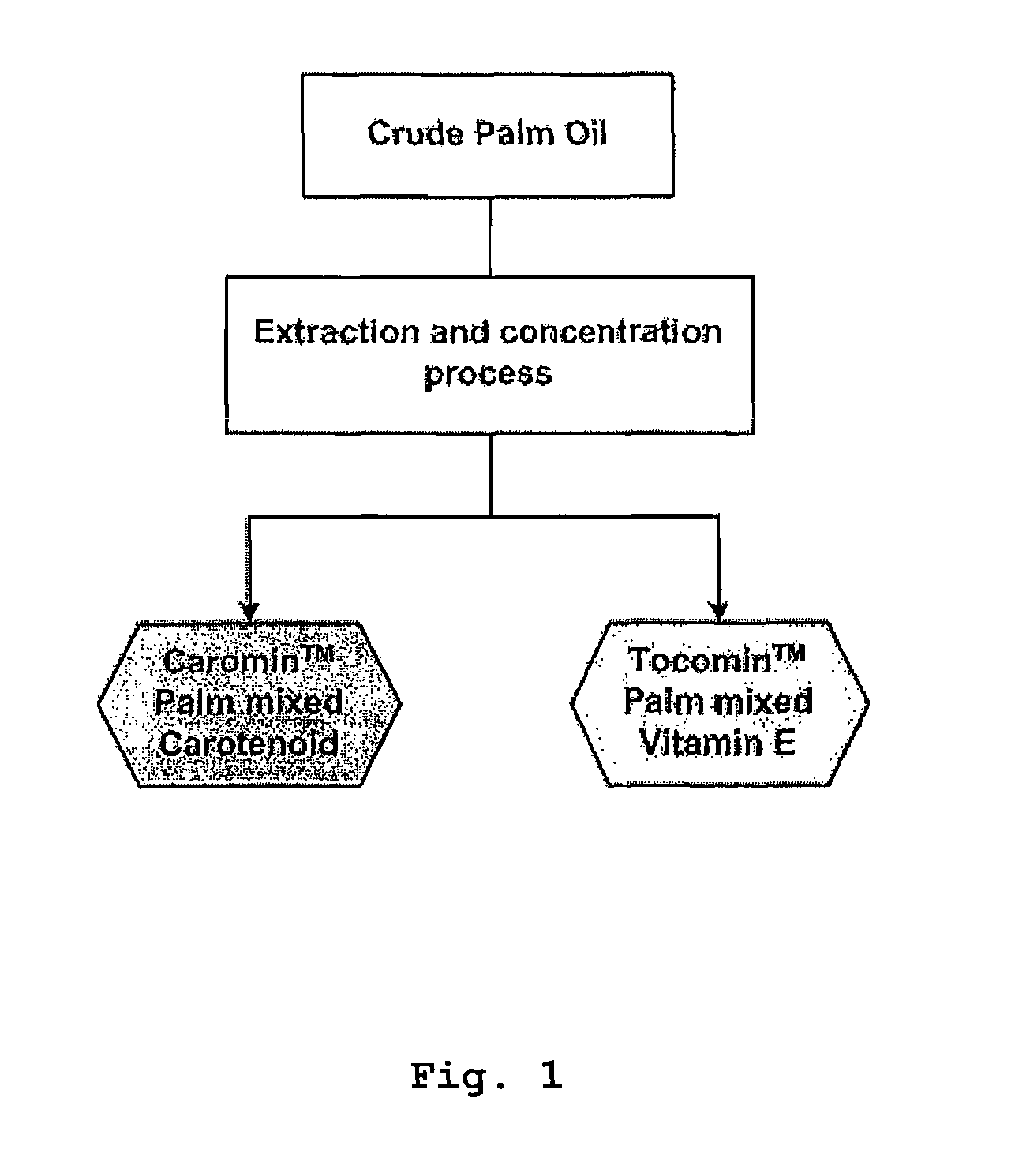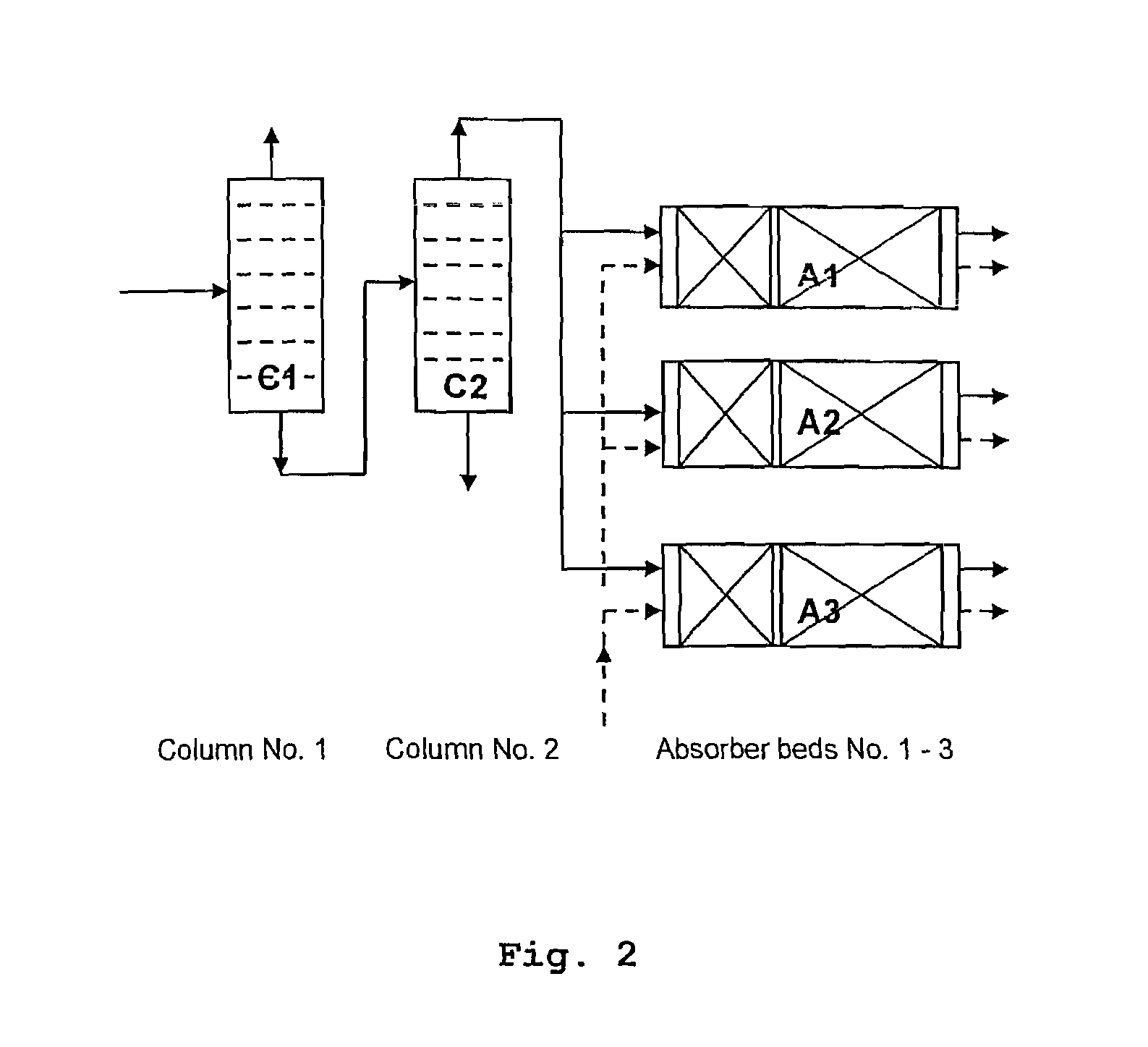Process for production of highly enriched fractions of natural compounds from palm oil with supercritical and near critical fluids
a technology of which is applied in the field of production of highly enriched fractions of natural compounds from palm oil with supercritical and near critical fluids, can solve the problems of inability to enrich with conventional methods, high viscosity of mixtures, and difficulty in achieving high-concentration fractions
- Summary
- Abstract
- Description
- Claims
- Application Information
AI Technical Summary
Benefits of technology
Problems solved by technology
Method used
Image
Examples
example 1
First Extraction Step
[0041]A continuous operated multi-stage supercritical extraction was conducted with pure carbon dioxide as solvent and a feed mixture containing 50 wt.-% tocochromanols (with γ-tocotrienol, α-tocotrienol, and α-tocopherol being the major components), 16 wt.-% squalene, 3 wt-% phytosterols (with β-sitosterol and campesterol being the most prominent species), and 11 wt.-% mono- and diglycerides. The employed column had an effective height of 6 m and was packed with a structured Sulzer EX packing. Operating conditions were as follows: 20 MPa, 323 K, solvent-to-feed ratio=19.8, reflux ratio=7.3. These conditions resulted in a top phase product consisting of 2 wt.-% FAME, 58 wt.-% squalene and it was completely depleted from tocochromanols and phytosterols. The bottom product consisted of 8 wt.-% squalene, 58 wt.-% tocochromanols, 4 wt.-% phytosterols, and it was completely FAME-free.
example 2
First Extraction Step
[0042]A continuous operated multi-stage supercritical extraction was conducted with pure carbon dioxide as solvent and a feed mixture containing 50 wt.-% tocochromanols (with γ-tocotrienol, α-tocotrienol, and α-tocopherol being the major components), 16 wt.-% squalene, 3 wt-% phytosterols (with β-sitosterol and campesterol being the most prominent species), and 11 wt.-% mono- and diglycerides. The employed column had an effective height of 6 m and was packed with a structured Sulzer EX packing. Operating conditions were as follows: 20 MPa, 343 K, solvent-to-feed ratio=40.3, reflux ratio=1.3. These conditions resulted in a top phase product consisting of 2 wt.-% FAME, 60 wt.-% squalene, 2 wt.-% tocochromanols, and 1 wt.-% sterols. The bottom product consisted of 7 wt.-% squalene, 54 wt.-% tocochromanols, 4 wt.-% phytosterols, and it was completely FAME-free.
example 3
Production of Concentrated Fractions of Tocotrienols-1
[0043]1 g of the bottom product obtained from example 1 was used as feed material and mixed with 10 g of silica gel, Zeofree 5170. The mixture is introduced into an empty vessel and supercritical CO2 was used to desorb FAME and squalene at 13 MPa and 333 K for 120 minutes. The pressure was increased to 25 MPa and after 60 minutes, a fraction (0.27 g), which contains 80 wt.-% of tocochormanols, was collected. The pressure was held constant for another 60 minutes, another fraction (0.24 g) was collected. This fraction contains approximately 100% tocochromanols.
PUM
| Property | Measurement | Unit |
|---|---|---|
| pressures | aaaaa | aaaaa |
| temperature | aaaaa | aaaaa |
| temperatures | aaaaa | aaaaa |
Abstract
Description
Claims
Application Information
 Login to View More
Login to View More - R&D
- Intellectual Property
- Life Sciences
- Materials
- Tech Scout
- Unparalleled Data Quality
- Higher Quality Content
- 60% Fewer Hallucinations
Browse by: Latest US Patents, China's latest patents, Technical Efficacy Thesaurus, Application Domain, Technology Topic, Popular Technical Reports.
© 2025 PatSnap. All rights reserved.Legal|Privacy policy|Modern Slavery Act Transparency Statement|Sitemap|About US| Contact US: help@patsnap.com


